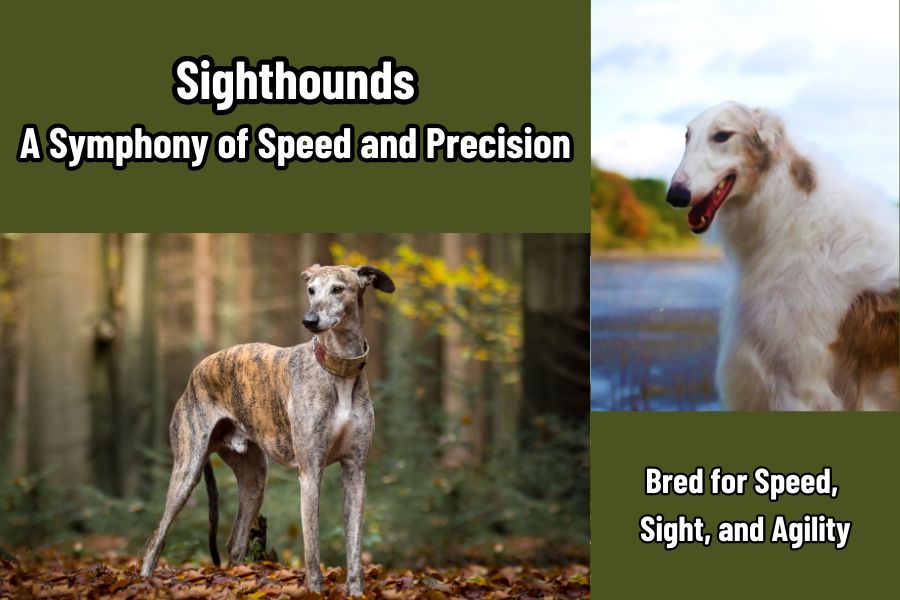Sighthounds, the epitome of speed and precision, are celebrated for their unique blend of agility and hunting prowess. Discover the rich history, diverse breeds, and essential care tips for these majestic dogs. Uncover why sighthounds are treasured companions for hunters and pet lovers alike.
Introduction
Imagine the sight of a sleek, graceful figure slicing through the open field, moving with an elegance and speed that seems almost otherworldly. Sighthounds, with their unparalleled agility and keen vision, have captivated humans for centuries. These dogs aren’t just pets; they’re a living testament to the art of the chase and the bond between hunter and hound.
In this article, we delve into the fascinating world of sighthounds. We’ll explore their ancient lineage, remarkable hunting skills, and the diverse breeds that make up this category. Whether you’re a seasoned hunter, a history buff, or someone curious about these majestic dogs, you’ll find a wealth of knowledge and insight here.
Did you know that sighthounds are among the oldest dog breeds, with a lineage tracing back to ancient civilizations like Greece and Rome? These dogs are still bred for hunting fast and agile prey, but also cherished as pets and racing champions worldwide. Join us as we unravel the symphony of speed and precision that defines the world of sighthounds.
The Majestic World of Sighthounds
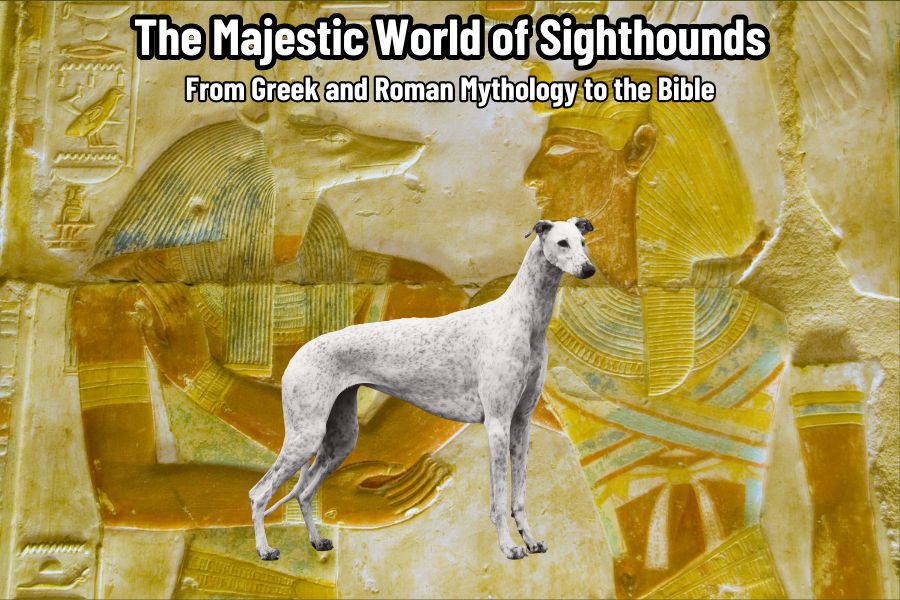
Sleek, elegant, and swift, sighthounds are a marvel of canine evolution. Their story is as captivating as their pursuit, reflecting a legacy intertwined with human history. Let’s journey into the majestic world of these extraordinary dogs, where speed and precision meet ancient lineage and modern versatility.
Sighthounds: One of the Oldest Dog Breeds
Sighthounds are believed to be the oldest type of dog on Earth, with a lineage tracing back thousands of years. Dogs similar to greyhounds appear in temple drawings of Egyptians and Celts from as early as 6,000 BC. Thought to be a cross between the domesticated dogs of ancient times and the southern European wolf, these dogs have evolved into the perfect hunting companions. Their streamlined bodies and keen eyesight have made them indispensable in the pursuit of game, carving out a unique niche in canine history.
From Greek and Roman Mythology to the Bible
Throughout history, sighthounds have been revered and even worshipped. In Greek and Roman mythology, they were depicted alongside gods and heroes, symbolizing nobility and prowess in the hunt. The Bible also mentions these noble hounds in Proverbs 30:31 (KJV), highlighting their esteemed status in ancient cultures. In medieval Europe, they were a symbol of status and nobility, often featured in the art and literature of the period. These references underscore the deep-rooted admiration humans have long held for these exceptional dogs, celebrating their unmatched hunting skills and graceful demeanor.
Modern Sighthounds and Hunting
While sighthounds were originally bred as hunting hounds, their roles have evolved over time. In America, many sighthounds, particularly greyhounds, are now cherished as pets and celebrated in racing circuits. However, their hunting heritage remains strong in countries like Spain, Russia, Ukraine, and parts of Asia, where these dogs continue to excel in their traditional roles. The sighthound’s ability to adapt and thrive in diverse environments speaks to their remarkable versatility and enduring appeal.
Sighthounds in Action: The Art of the Chase
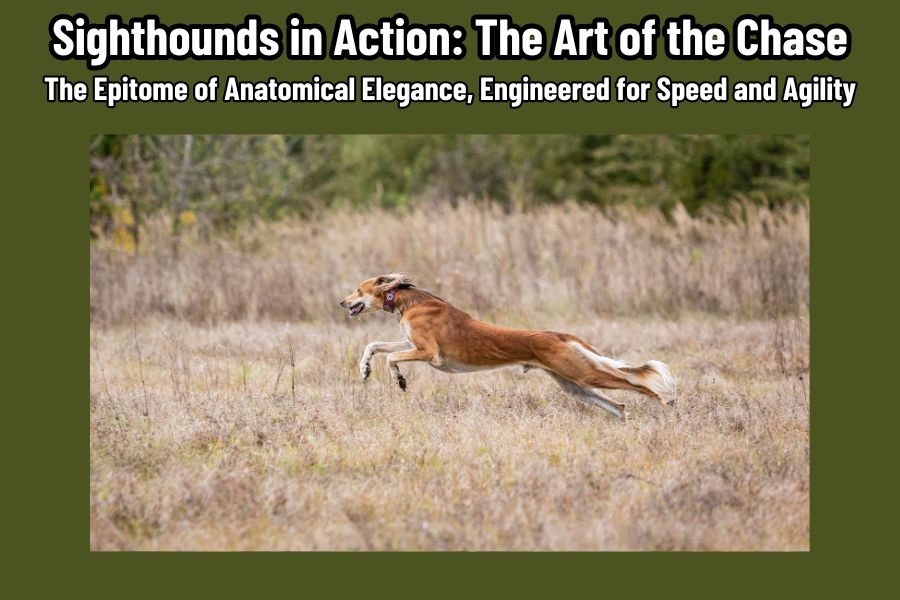
Imagine a sighthound in full stride, muscles rippling under a sleek coat, eyes locked on distant prey. The beauty and precision of their chase are nothing short of breathtaking. This section delves into the remarkable physical traits and hunting techniques that make sighthounds the unparalleled masters of pursuit.
Sighthounds: Bred for Speed, Sight, and Agility
Sighthounds are the epitome of anatomical elegance, engineered for speed and agility. Their long legs and lean bodies minimize air resistance, allowing them to reach astonishing speeds, with Greyhounds clocking up to 45 miles per hour. Their deep chests house powerful hearts and lungs (larger than other similar sized dogs), providing the stamina required for long chases. Additionally, their large, forward-facing eyes offer a wide field of vision, essential for spotting prey from great distances. This unique combination of traits enables sighthounds to excel in hunting and racing, their bodies a perfect synergy of power and grace.
Sighthounds: Masters of Pursuing Fast, Agile Prey
When a sighthound spots its target, the chase begins with an intensity that’s almost palpable. Utilizing their keen vision, they lock onto the movement of prey, often from hundreds of yards away. Their powerful legs propel them forward in a series of explosive strides, swiftly closing the distance. The pursuit is a ballet of speed and strategy, with the sighthound anticipating and mirroring the prey’s every move.
Coursing, a sport where dogs chase live game or mechanical lures, epitomizes the hunting prowess of sighthounds. This practice not only showcases a sighthounds incredible speed and agility but also their sharp instincts and intelligence. Coursing is a testament to the breed’s enduring hunting capabilities and serves as a modern homage to their ancient role as hunters. In many parts of the world, coursing remains a popular sport, preserving the rich heritage of these magnificent dogs.
Diversity within the Ranks: Sighthound Breeds
The world of sighthounds is rich with diversity, showcasing a variety of breeds that each bring unique traits and histories to the table. From the regal Afghan Hound to the swift Greyhound, each breed offers a fascinating glimpse into the evolution of these magnificent hunters. Let’s explore the origins, physical characteristics, and behavioral traits of some notable sighthound breeds.
Afghan Hound: The Elegant Nomad of the Mountains
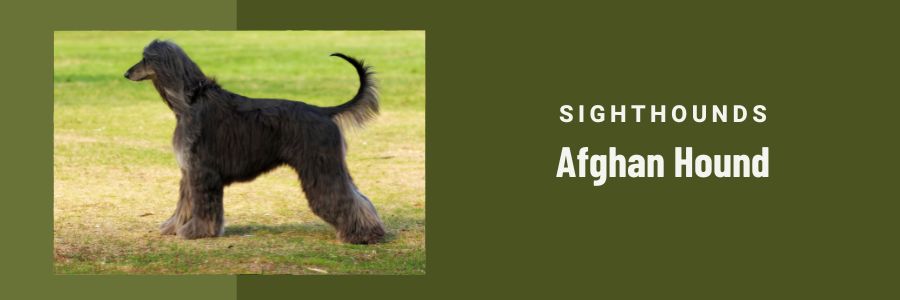
Origin and History
The Afghan Hound hails from the rugged mountains of Afghanistan, where it was prized for its hunting prowess and ability to navigate harsh terrains. These dogs were bred by nomadic tribes for their speed and endurance, making them ideal for chasing down game in the unforgiving landscape.
Physical Traits
Afghan Hounds are known for their striking appearance. They stand between 25 to 27 inches tall and weigh around 50 to 60 pounds. Their long, silky coat, which comes in various colors, provides insulation against extreme weather. With a life expectancy of 12 to 14 years, these dogs possess keen senses that make them formidable hunters.
Behavioral Traits
Afghan Hounds have a high prey drive and are incredibly athletic, capable of great speed and agility. They are known for their independent and sometimes aloof nature, which can make training a challenge. However, with patience and consistency, they can be loyal and affectionate companions. While they can be good family dogs, their reserved temperament requires socialization from an early age.
Azawakh: The Graceful Hunter of the Sahara
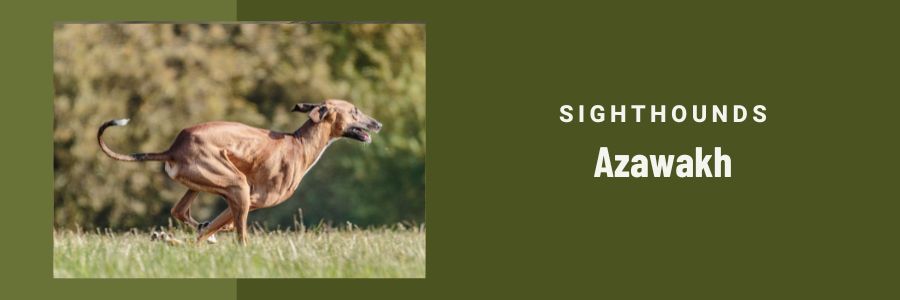
Origin and History
Originating from the Sahel region of Africa, the Azawakh has been a companion of the nomadic Tuareg people for centuries. These dogs were bred for their speed and stamina, essential traits for hunting in the vast, open landscapes of the Sahara.
Physical Traits
The Azawakh is a tall and slender breed, standing 24 to 29 inches tall and weighing between 33 to 55 pounds. They have a short, fine coat that comes in various colors, including fawn, brindle, and blue. Known for their elegant and athletic build, Azawakhs have a life expectancy of 10 to 12 years and possess sharp senses that aid in their hunting abilities.
Behavioral Traits
Azawakhs are known for their high prey drive and exceptional speed, making them excellent hunters. They are loyal and protective of their families but can be wary of strangers. With proper training and socialization, they can be affectionate pets. Their independent nature means they may require a firm yet gentle hand during training.
Borzoi: The Aristocratic Wolf Hunter
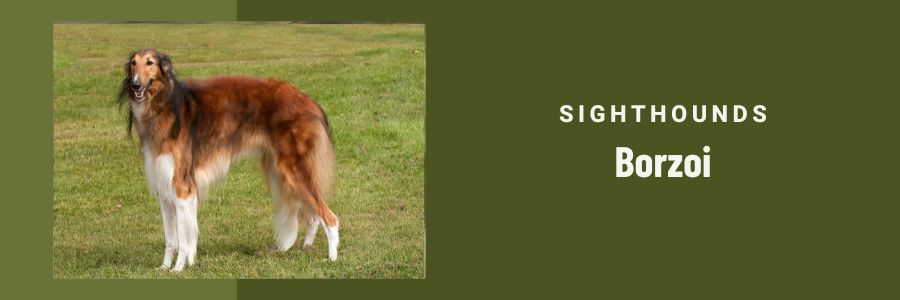
Origin and History
The Borzoi, also known as the Russian Wolfhound, has a rich history dating back to the Russian aristocracy. Bred by Russian nobles for hunting wolves, these dogs were valued for their strength, speed, and courage.
Physical Traits
Borzois are large, standing 26 to 32 inches tall and weighing 60 to 105 pounds. They have a long, silky coat that can be wavy or curly, and come in a variety of colors. With a life expectancy of 10 to 12 years, these dogs are known for their graceful, slender bodies and sharp eyesight.
Behavioral Traits
Borzois have a strong prey drive and are known for their speed and endurance. They are typically gentle and calm around their families but can be reserved with strangers. Borzois are intelligent and can be trained, though they may exhibit a stubborn streak. Their gentle nature makes them good family dogs, especially in a calm environment.
Chortai: The Versatile Eastern Greyhound
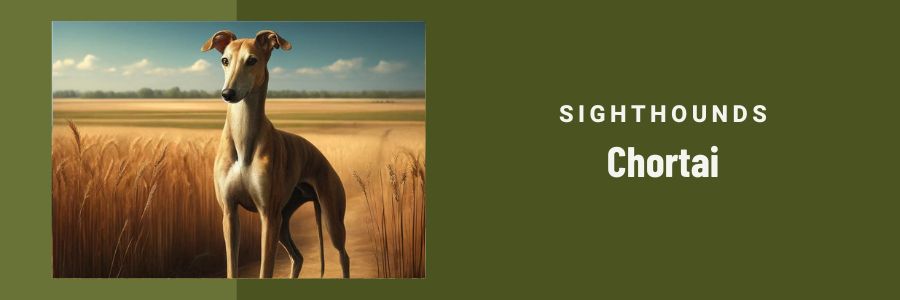
Origin and History
The Chortai, sometimes spelled Chortaj, is a breed of sighthound from Ukraine. Also known as the Chortai Eastern Greyhound, this breed has been a part of Ukrainian culture for centuries. Historically, Chortais were prized for their speed and agility, used primarily for hunting hares, foxes, and other small game in the open plains and forests of Ukraine.
Physical Traits
Chortais are medium-sized, standing 24 to 28 inches tall and weighing 45 to 70 pounds. They possess a lean, muscular build that contributes to their exceptional speed and agility. Their short, dense coat can come in various colors, providing them with a sleek appearance. Known for their keen eyesight and acute senses, Chortais have a life expectancy of around 12 to 14 years.
Behavioral Traits
Chortais are highly athletic and have a strong prey drive, making them excellent hunters. They are known for their versatility and can adapt to various hunting tasks, showcasing remarkable endurance and determination. Loyal and protective of their families, Chortais can be reserved with strangers but are affectionate with those they trust. With proper training and socialization, Chortais can make good family dogs, balancing their hunting instincts with a loving demeanor at home.
Greyhound: The Iconic Speedster
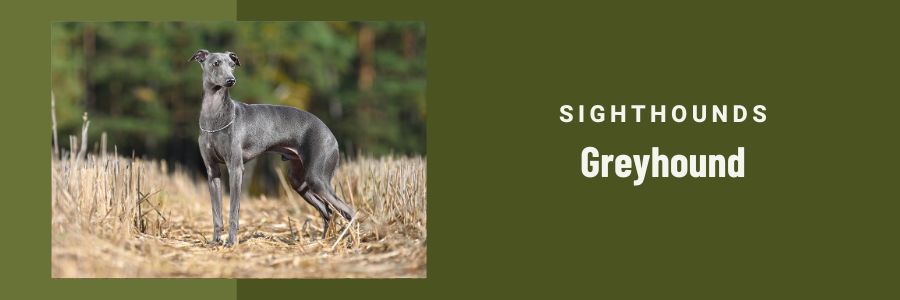
Origin and History
Greyhounds are among the oldest purebred domesticated dog breeds with a history dating back roughly 8,000 years ago. It’s common belief that all sighthound breeds are descended down from the ancient greyhounds.
Physical Traits
Greyhounds are tall and lean, standing 27 to 30 inches tall and weighing 60 to 70 pounds. They have a short, smooth coat that comes in various colors, including black, white, fawn, and brindle. Known for their incredible speed, Greyhounds can reach up to 45 miles per hour. Their life expectancy is 10 to 14 years.
Behavioral Traits
Greyhounds are great hunting dogs because they have a high prey drive and are known for their athleticism. They are also gentle and friendly dogs, making them excellent companions. Despite their hunting and racing heritage, Greyhounds are often calm and enjoy lounging around the house. They are easy to train and can be very loyal, making them exceptional family dogs.
Irish Wolfhound: The Gentle Giant of the Emerald Isle
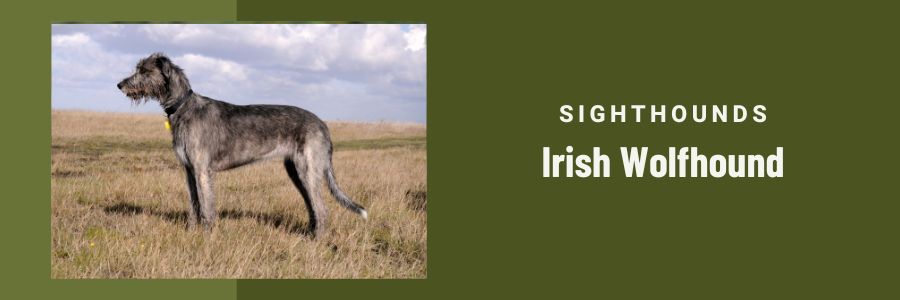
Origin and History
The Irish Wolfhound has a storied past that dates back to ancient Ireland, where it was bred to hunt wolves and other large game. Known as the “Wolfdog of Ireland,” these formidable canines were highly valued by Irish chieftains and kings for their bravery and strength.
Physical Traits
Irish Wolfhounds are one of the tallest dog breeds, standing between 32 to 35 inches tall and weighing up to 180 pounds. They have a rough, wiry coat that can come in various colors, including gray, brindle, red, black, and white. They have a short life expectancy of 6 to 8 years. They possess keen senses and a powerful build designed for endurance and strength.
Behavioral Traits
Despite their imposing size, Irish Wolfhounds are known for their gentle and friendly nature. They have a moderate prey drive and are relatively easygoing, making them great companions. Their loyalty and calm temperament make them excellent family dogs, although their size requires ample space. Training them is relatively straightforward due to their intelligent and willing nature.
Saluki: The Royal Hunter of the Desert
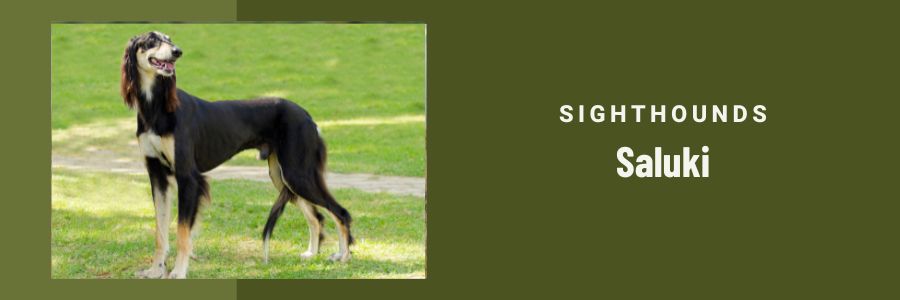
Origin and History
The Saluki, often referred to as the “Royal Dog of Egypt,” has a history that stretches back to ancient Mesopotamia. These sighthounds were revered by pharaohs and nobility for their speed and hunting abilities, often depicted in ancient art and mythology.
Physical Traits
Salukis are elegant and slender, standing 23 to 28 inches tall and weighing between 35 to 65 pounds. They have a smooth or feathered coat that comes in a variety of colors, including white, cream, fawn, and black and tan. Known for their keen eyesight and remarkable endurance, Salukis typically live 12 to 14 years.
Behavioral Traits
Salukis have a high prey drive and are incredibly athletic, capable of running at speeds up to 42 miles per hour. They are known for their independent yet gentle temperament, requiring patient and consistent training. Salukis can be reserved with strangers but are affectionate with their families, making them good pets for those who appreciate their unique characteristics.
Sloughi: The Noble Coursing Dog of North Africa
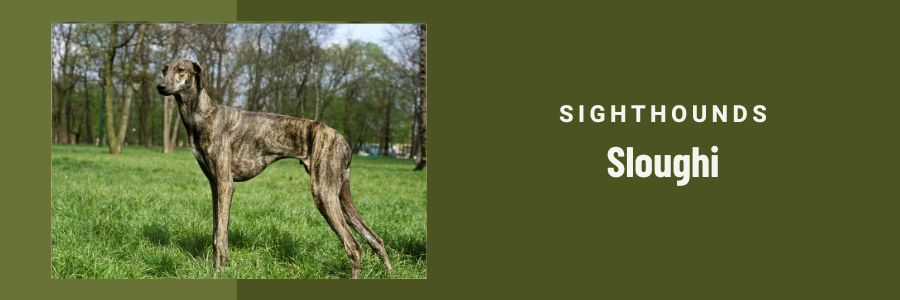
Origin and History
The Sloughi, native to North Africa, particularly Morocco, has been a prized hunting companion for centuries. This breed was traditionally used by the Berber tribes to hunt game in the harsh desert environment, valued for its speed and endurance.
Physical Traits
Sloughis are medium to large dogs, standing 24 to 29 inches tall and weighing between 45 to 70 pounds. They have a short, smooth coat that can be various shades of sand, red, fawn, and brindle. Known for their streamlined, athletic build, Sloughis have a life expectancy of 12 to 15 years.
Behavioral Traits
Sloughis are known for their high prey drive and exceptional hunting skills. They are loyal and affectionate with their families but can be aloof with strangers. These sighthounds require proper training and socialization from an early age to thrive as pets. Their intelligence and keen senses make them excellent hunting dogs, as well as loving companions.
Tazy: The Versatile Hunter of Central Asia
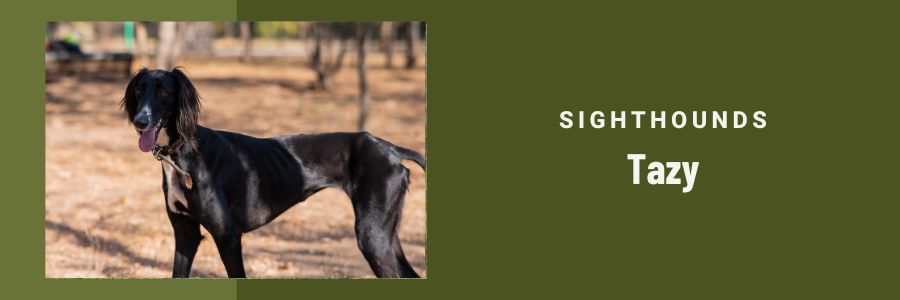
Origin and History
The Tazy originates from Kazakhstan, the steppes of Central Asia. Historically, these dogs were used by nomadic tribes for hunting a wide range of game, from hares to wolves, prized for their versatility and resilience. Considered one of the oldest dog breeds in the world.
Physical Traits
Tazys are medium-sized dogs, standing 23 to 27 inches tall and weighing between 35 to 60 pounds. They have a short, dense coat that can come in various colors, including black, fawn, and brindle. With a life expectancy of 10 to 14 years, Tazys possess keen senses and a muscular, agile build.
Behavioral Traits
Tazys have a high prey drive and are known for their athleticism and agility. They are versatile hunters and can adapt to various terrains and game. These dogs are loyal and protective of their families but can be wary of strangers. Proper training and socialization are essential for Tazys to be good family pets, as they are intelligent and independent by nature.
Whippet: The Swift and Gentle Racer
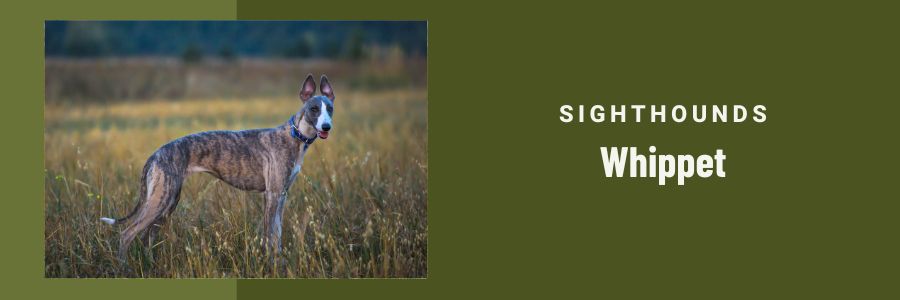
Origin and History
The Whippet, often referred to as the “Poor Man’s Racehorse,” was developed in England during the 19th century. Bred from small Greyhounds and terriers, Whippets were used for racing and hunting small game, particularly rabbits.
Physical Traits
Whippets are medium-sized dogs, standing 18 to 22 inches tall and weighing 25 to 40 pounds. They have a short, smooth coat that comes in various colors, including black, white, fawn, and brindle. Known for their sleek and aerodynamic build, Whippets have a life expectancy of 12 to 15 years.
Behavioral Traits
Whippets are gentle and friendly dogs with a moderate prey drive. They are known for their incredible speed, capable of reaching up to 35 miles per hour. Whippets are easy to train and have a calm, affectionate temperament, making them excellent family pets. Their loyalty and adaptability make them well-suited to both active and relaxed lifestyles.
Other Sighthound Breeds
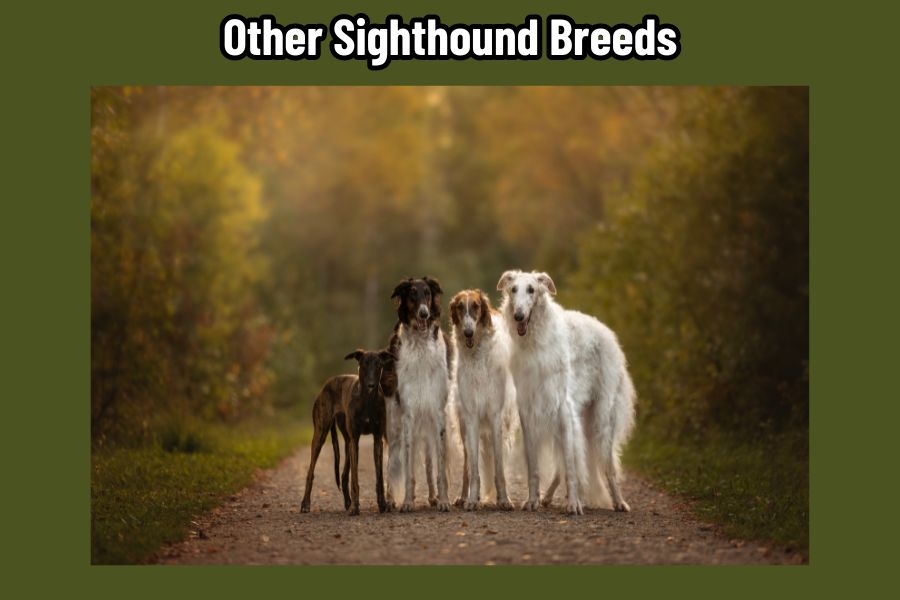
In future posts, we will delve into the fascinating details of these sighthound breeds, each with its unique characteristics and history.
- Chippiparai: A sleek and agile breed from India, known for its hunting prowess and loyalty.
- Galgo Español: A Spanish breed famed for its endurance and speed, often used in hare coursing.
- Italian Greyhound: A miniature sighthound with a graceful appearance, beloved as a companion dog.
- Kaikadi: A rare Indian breed, traditionally used for hunting and known for its keen senses.
- Kanni: A loyal and intelligent hunting dog from Tamil Nadu, India, prized for its agility.
- Kombai: A powerful and courageous sighthound from India, historically used for hunting large game.
- Levriero Sardo: A Sardinian sighthound with a slender build, known for its speed and agility.
- Magyar agár: Also known as the Hungarian Greyhound, this breed excels in both hunting and racing.
- Mudhol Hound: An Indian breed renowned for its speed and stamina, often used for hunting.
- Old Croatian Sighthound: An ancient breed from Croatia, celebrated for its hunting skills and endurance.
- Patagonian Greyhound: A South American breed known for its speed and agility, used primarily in hunting.
- Polish Greyhound: A robust and versatile hunting dog from Poland, adept at chasing a variety of game.
- Rajapalayam: An Indian sighthound with a striking white coat, valued for its loyalty and hunting abilities.
- Rampur Greyhound: A tall and sturdy sighthound from India, renowned for its speed and strength.
- Scottish Deerhound: A large and noble breed from Scotland, historically used for hunting deer.
- Silken Windhound: A graceful and friendly breed, developed in the United States for both companionship and agility.
- Taigan: A Central Asian sighthound known for its endurance and ability to hunt in harsh conditions.
- Xigou: A Chinese sighthound breed, appreciated for its speed and keen hunting instincts.
Caring for Sighthounds

Caring for sighthounds involves understanding their unique needs and ensuring they receive regular training, nutrition, healthcare, and emotional connection. These dogs, bred for speed and agility, thrive when their specific requirements are met. Let’s explore how to keep your sighthound healthy, happy, and ready for action.
Refresher Training Tips for Sighthounds
Coursing is a natural activity for sighthounds, allowing them to exercise their instinctual drive to chase. Start with the basics, short, controlled sessions to build stamina and focus. Use a lure or a toy to simulate prey, encouraging your dog to chase and catch it. Keep your commands consistent so you (not the dog) are always in control. Regular practice sessions not only sharpens their skills but also provides excellent physical exercise.
For competitive coursing and hunting, advanced strategies are essential. Along with the basics, start introducing varied terrains to simulate real hunting environments and practice directional commands to improve control and response. Gradual increases in distance and complexity of the chase will enhance their agility and endurance. Remember, consistency along with positive reinforcement is key to maintaining enthusiasm and performance.
Nutritional Tips
Nutritional needs for sighthounds are unique due to their lean and athletic build. High-quality, protein-rich diets are essential to maintain muscle mass and energy levels. Include lean meats, fish, and whole grains, and ensure a balanced intake of vitamins and minerals. Regular feeding schedules and portion control help prevent obesity, keeping your sighthound in prime condition.
Healthcare Tips
Regular health check-ups are crucial for managing common breed-specific issues in sighthounds. These dogs can be prone to conditions like hip dysplasia, bloat, and heart disease. Routine veterinary visits, along with preventive measures like vaccinations and parasite control, are essential. Monitoring their weight and physical condition will help in early detection and management of potential health problems.
Forging a Deep Connection
Forging bonds with your sighthound goes beyond training and physical care. Spend quality time with your dog through activities they enjoy, such as playtime, gentle grooming, and quiet companionship. Building trust and understanding enhances your relationship, making your sighthound not just a hunting partner but a loyal and affectionate companion.
Conclusion
We’ve explored sighthounds ancient lineage and their unique anatomical and physiological traits. We examined notable sighthound breeds from the Afghan Hound’s elegance to the Greyhound’s iconic speed, each breed offering distinct characteristics that make sighthounds extraordinary. We also covered some important tips on training, nutrition, healthcare and bonding, all crucial in keeping your sighthound in prime condition.
Sighthounds, with their remarkable speed, keen eyesight, and rich history, continue to captivate and serve as some of the best hunting dogs and beloved companions.
FAQs: Sighthounds
Below are some common questions and answers about sighthounds:
What makes a dog a Sighthound?
A dog is classified as a sighthound based on its exceptional vision and ability to chase and catch prey by sight rather than scent. These breeds are characterized by their slender, athletic build, long legs, and keen eyesight, enabling them to spot and pursue fast-moving game over long distances.
Where did Sighthounds originate?
Sighthounds have ancient origins, with evidence suggesting they first appeared in regions such as the Middle East, Africa, and parts of Europe. Breeds like the Saluki and Greyhound trace their lineage back thousands of years to ancient civilizations, where they were highly valued for their companionship and hunting prowess.
What is the only dog mentioned in the Bible?
The Greyhound is the only dog breed specifically mentioned in the Bible. In Proverbs 30:31 (KJV), it states: “The greyhound, the he-goat also, and the king, against whom there is no rising up.” This highlights the breed’s esteemed status even in ancient times.
What is the fastest Sighthound?
The Greyhound holds the title for the fastest sighthound, capable of reaching speeds up to 45 miles per hour. This incredible speed, combined with their agility and endurance, makes them exceptional in both hunting and racing.
What is the most intelligent Sighthound?
The Saluki is often considered one of the most intelligent sighthounds. Known for their independence and problem-solving abilities, Salukis require thoughtful training methods that respect their unique intelligence and instincts.
Are Sighthounds good family dogs?
Yes, sighthounds can be excellent family dogs. While their high prey drive and athletic nature mean they need ample exercise and mental stimulation, they are typically gentle, loyal, and affectionate with their families. Breeds like the Greyhound and Whippet are known for their calm and friendly demeanor, making them well-suited for family life.
Resources: Sighthounds
These resources provide a wealth of information for anyone interested in the unique and fascinating world of sighthounds.
SPECIAL NOTE: “The information provided in this post is based on Google research and the Resource links listed below. While we try to keep the information for this post current, there are no representations expressed or implied, about the completeness, or accuracy of the information provided. Therefore all hunters should always verify current information from these resources along with other local and federal publications”.
Online Resources
AKC – American Kennel Club
TKC – The Kennel Club
UKC – United Kennel Club
CKC – Canadian Kennel Club
Best Books
- “Sighthounds: Their Form, Their Function and Their Future” by David Hancock
- A comprehensive guide that explores the history, physical traits, and roles of various sighthound breeds.
- “The Complete Greyhound” by Dennis McKeon
- An in-depth look at Greyhounds, covering their history, care, training, and involvement in racing and adoption.
- “The Saluki: Chasing the Wind” by Brian Patrick Duggan
- A detailed account of the Saluki breed, including its ancient origins, cultural significance, and modern-day care and training.
- “Running Dog Maintenance” by M. Louise Greig
- A practical guide focusing on the care and training of sighthounds, with insights into maintaining their health and conditioning for racing and hunting.
- “Sighthound Field Coursing: The History, Sport and Modern-Day Challenges” by J. M. Colter
- This book delves into the history and evolution of field coursing, highlighting the role of sighthounds in this sport.

